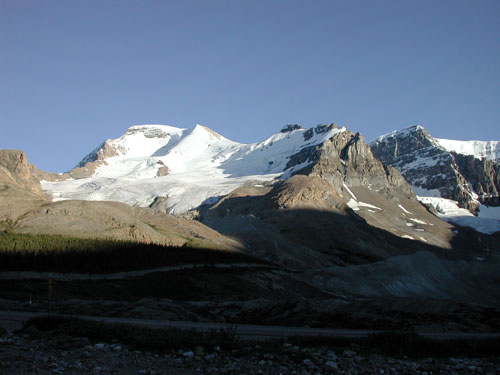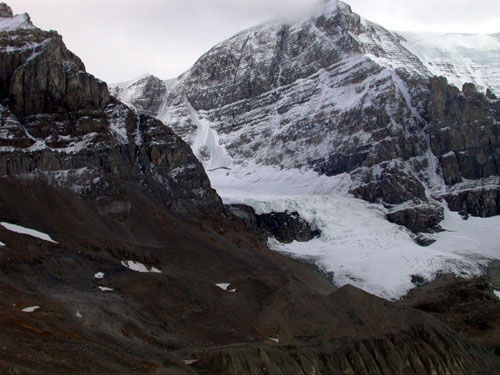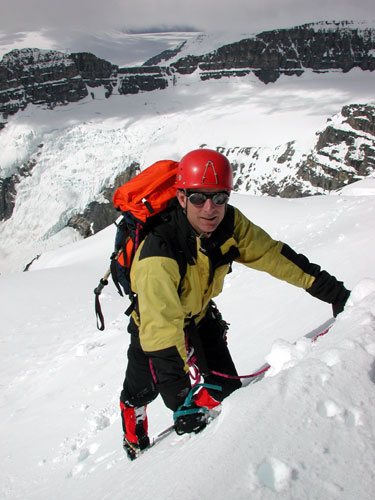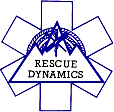This route was becoming increasingly popular as it had fewer objective hazards than the North Glacier Route. It still has a number of obvious and hidden dangers that will be described below. This was often one of the first choices for the summit day on day three of the Basic Snow and Ice Course (day five of Intro to Mountaineering). In 2023 the approach to the route has become increasingly hazardous, so the following description may not be valid any longer. The summit is 11.452 feet / 3491 meters above sea level which means altitude sickness, although rare, is possible and has happened here. Quite often fit individuals will suffer from minor affects of altitude during our climbs. Headaches and feeling unduly tired are common complaints. Keeping hydrated and fed are two ways to combat this, along with proper pacing and well spaced breaks. Crevasse hazard is more manageable on this route than the North Glacier for much of the season. It still varies depending upon the time of year, the time of day and the quality of the snowpack. Good routefinding and proper ropework are still essential to safety. On this route a slip or fall is more of a danger than crevasses so the way in which the rope is used will vary as the day progresses. In addition, depending upon the conditions, the way in which the rope will be used can vary from one day to the next even when travelling on exactly the same route. Judgment and situational awareness are key to proper ropework. This route normally does not traverse under seracs or icefall (unless you are lost or get off route). Just to the side of the lower part of the route there is substantial icefall hazard that can be almost completely avoided when on the correct route. Avalanches can also happen here especially on the steep slope above the flat lower portion of the "AA" Glacier. Avalanches here are more likely just after a snow storm, in early season or in the afternoon as the snow warms up and weakens. Avalanches are also more likely on a day following a warm night during which the snow did not freeze well at night. Best conditions follow a cold clear night which freezes things in place. It is still best to get up very early and start your climb in the dark so that the descent is made early in the day before the hazard level rises. You also have to be willing to turn back if conditions are too warm or the snow is still moist early in the morning. During our guided ascents we take groups on this route when we feel the conditions are poor on the North Glacier Route but exceptable on this side of the mountain where the route is in shade until around 11:00 AM. Sometimes we will ascend one route and descend another if conditions warrant a change of plan. If conditions are poor here in the morning we sometimes consider Boundary peak which is easier and even less objectively hazardous. The photos in this essay were taken on the fifth wedding anniversary of Dave and Cheryl Devin. Dave and Cheryl were married on the summit five years ago by me (Cyril). On the wedding day Sandra was the videographer and she made the ascent again today. All of the folks in these photos have summitted Mt. Athabasca more than once. This was Cheryl's third ascent; Dave had made multiple ascents including the North Face; Sandra had many ascents including this route, the North Glacier Route and the Silverhorn Face Route. This was my 75th ascent if my current count is correct! I have climbed the peak by six different routes in most conditions and during most months of the year at one time or another. The lower portion of the AA glacier is shown in the center of the photo below. The route goes up the far left hand side of the glacier and passes the obvious icefall via easy rocks on the climber's left. The peak behind the glacier on the right is Mt. Andromeda. The name "AA Col" comes from the fact that the col or pass is between Mounts Athabasca and Andromeda.

The AA Col Route on Mt. Athabasca

![[N Face Photo]](Ropeup062703.jpg)
![[Pitch 2 Photo]](IcefallAM062703.jpg)
![[Leading Pitch 5 Photo]](Rockstep062703.jpg)
![[Pitch 5 Photo]](Cramponson062703.jpg)
![[Pitch 5 Photo]](AAbowl062703.jpg)
![[Pitch 6 Photo]](AAglaclow062703.jpg)
![[Pitch 7 Photo]](AAfacetop062703.jpg)
![[Crux Pitch Photo]](Saddle062703.jpg)
![[Crux Pitch Photo]](AA11000062703.jpg)
![[Lee on Pitch 7 Photo]](viewsilv062703.jpg)
![[Lee Past Crux Photo]](summitA062703.jpg)

![[Photo of Cyril on Summit]](Wilcox062703.jpg)
![[Photo of Cyril on Summit]](toprest062703.jpg)
![[Photo of Cyril on Summit]](toprest2062703.jpg)
![[Photo of Lee on Summit]](descentsilv062703.jpg)
![[Photo of Lee on Summit]](descentAAface062703.jpg)
![[Photo of top of N Face]](descentlower062703.jpg)
![[Photo of Lee on Summit]](trio062703.jpg)
![[Photo of Lee on Summit]](ropeoff062703.jpg)
![[Photo of Lee on Summit]](icefall062703.jpg)
![[Photo of Lee on Summit]](moraineA062703.jpg)
![[Photo of top of N Face]](moraineB062703.jpg)
